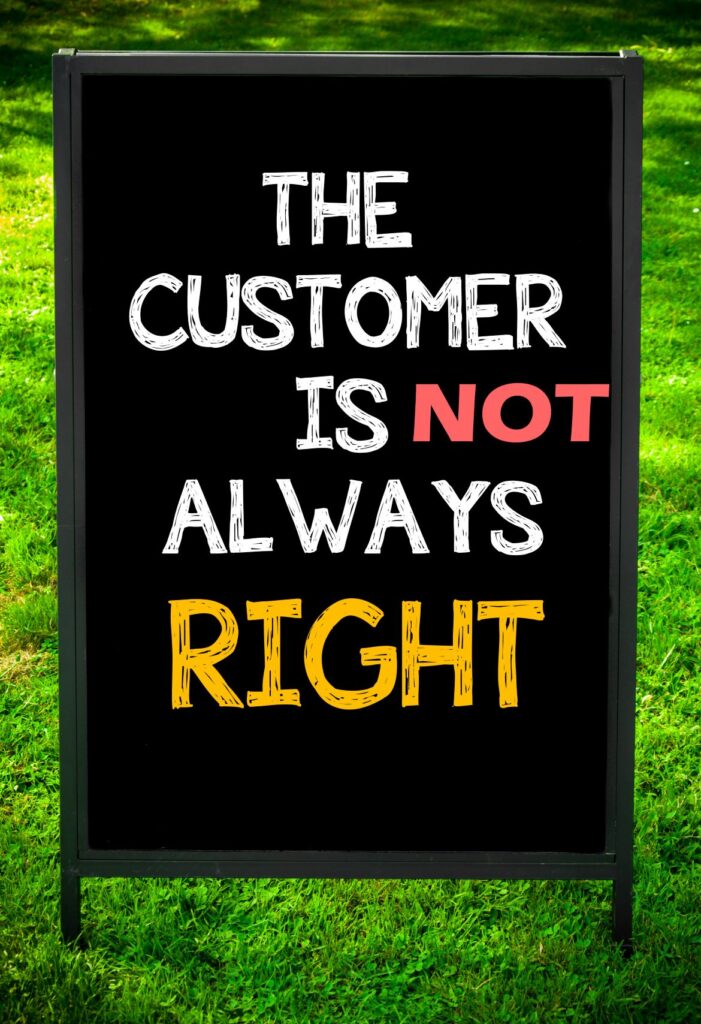The number one most incorrect quote about customer service that is perpetuated time and again, is: “The Customer is Always Right.”
WRONG!
Training employees to believe this fallacy and insisting that they live by it is not only wrong, but it’s bad for business. Consider these situations:
- Would you let a naked customer dine in your restaurant just because he or she wanted to?
- If a customer told you your best employee should be fired because he didn’t like the employee’s physical appearance, would you fire the employee?
- If a customer complained that your service was lousy, but you consistently receive stellar customer service feedback, does that mean your service is always bad?
- If a customer is berating an employee, name calling and using profanity, does he or she have the right to do so?
No, of course not.
We need to stop living by the philosophy of, “The customer is always right,” and start focusing on doing the right thing- for the organization, for our employees, and for our “right fit” customers. Here’s why:
1.Some customers are unreasonable.
One of my favorite airlines is Southwest Airlines. I like them because they’re reasonably priced, don’t “nickle and dime” me, and have always provided me with great service. Because I often fly Southwest, it doesn’t bother me that I don’t have an assigned seat and I have to line up with my boarding group. However, I’ve been in line behind repeat Southwest passengers who complain to gate agents about not having assigned seats and having to board with a specific group. Give me a break people! It’s not like you didn’t know the rules BEFORE you got to the gate. These unreasonable customers are a “wrong fit” for this airline. They should just suck-it-up and pay more to have a seat number on their tickets. I’m sure Southwest won’t be sorry to see them go. These are not the type of customers they’re after.
2. Some customers have unrealistic expectations.
A friend who owns a restaurant recently told me about a customer who came in and ordered two entrees, ate from both of them, but wanted to send one back and not pay for it. There was nothing wrong with the meal, she just wanted to be able taste both entrees before deciding which one she wanted to eat. When the customer was told she could not “return” an entree unless there was a problem with it, she got angry, saying that she always did this at other restaurants. Unfortunately, this customer had built unrealistic expectations based on her experiences with other restaurants. At my friend’s place, she was told kindly and politely that they could not comp the second entree and she reluctantly paid the bill and has not been back.
However, my friend is fine losing such a customer. She feels that if a customer orders something and her staff go to the trouble of preparing and serving it, they deserve to be paid for the meal. She said, “I used to believe the customer was always right, but I’ve learned that a customer like this is never going to be happy and you’re better off letting her go.”
3. Some customers don’t know what they want or need.
Good customer service providers know it’s their job to try to find a solution that’s BEST for the customer, not just what customers say they want. They do this by asking great questions, finding out the end result the customer is seeking, and sharing the best possible solutions based on their expertise. Oftentimes, the solution may not be something the customer has ever thought of.
For example, I often have clients ask if I do “team-building training,” which I do. However, I’ve learned through 20+ years of experience that when someone asks for team building, they’re not usually trying to build a new team of employees. In fact, they often don’t even have a team, but simply a group of employees.
By asking the right questions, I’m able to uncover that what they REALLY need is conflict resolution training, supervisory skills training for their leaders, or something else. In some cases, the issue is something that can’t be fixed with training. In these last instances, I’m losing a sale in the short term, because I could have just said, “Yes, I can do a team-building workshop for you,” but when the workshop didn’t fix the customer’s problem, I would lose a customer in the long term.
4. Shockingly, some customers are just plain wrong.
Many organizations have installed video cameras in customer service areas to have the ability to follow up on customer complaints. Time and time again I hear from my clients that they’ve reviewed videotape where a customer accuses an employee of something that just didn’t happen. Sometimes customers just make mistakes, other times customers lie in an attempt to get what they want. Either way, customers aren’t always correct.
The bottom line is, the customer is not always right, but you wouldn’t have a business if you had no customers. What organizations need to do is to focus on making “right fit” customers happy when they can, and letting “wrong fit” customers go.








Thank you Amy for the different perspective on this issue. Agree, the fact is, that some customers will never be happy and it is best not to spend time & resources on them. Better to use those resources are “right fit” customers.
Appreciate the feedback! Thanks for commenting. You’re right- no matter what you do, there are some people that just don’t want to be happy or to resolve the issue.